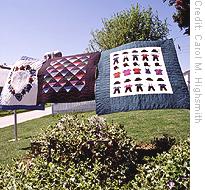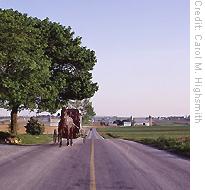VOA标准英语2008年-Some Americans Have No Interest in the Hottest(在线收听)
 |
| At an Amish lumber mill, where saws and pulleys are run by gasoline generators rather than electricity, even sawdust is conserved for use in making fiberboard |
Married Amishmen wear beards and straw hats. Women wrap their hair tightly into buns beneath prayer coverings. Amish work – farming, weaving, furniture-making – is long and hard.
 |
| These quilts are designed as one of the Amish's few home decorations - wall hangings, not to warm a bed. They are sold in local shops and are quite expensive |
Amish typically have five or more children. They build more and more wings onto their farmhouses to accommodate new generations and aging adults. Given a free and open chance to leave the sect, four of five Amish young adults elect to stay.
All of which helps explain the following:
According to researchers at Elizabethtown College in Lancaster County, Pennsylvania – a region where gawking at the Amish has become a popular tourist activity – there are more than 225,000 Amish nationwide – almost twice as many as there were in 1992. In that time, Amish have moved into 16 new states as far west as Colorado.
 |
| Amish buggies keep to the far, far right on rural roads to allow automobiles to pass. Local buggy and blacksmith shops are tourist attractions |
The Amish, who came to America from the Alsace region of France in the early 1700s in search of religious tolerance, do not live in communes. Their handsome farms are spread among their non-Amish neighbors. There are no Amish churches or religious icons other than the Christian Bible, and no special creed other than Christ's example of living simply and humbly and helping others.
The Amish made headlines two years ago by forgiving and embracing the widow of a homicidal milkman who killed five Pennsylvania Amish girls.
Living without telephones or computers, or even electricity, the Amish happily allow the Information Age to pass them by. Questioned about their apparent backward ways, they ask their neighbors, Where has progress gotten you? Are you happier? More fulfilled? More loved?